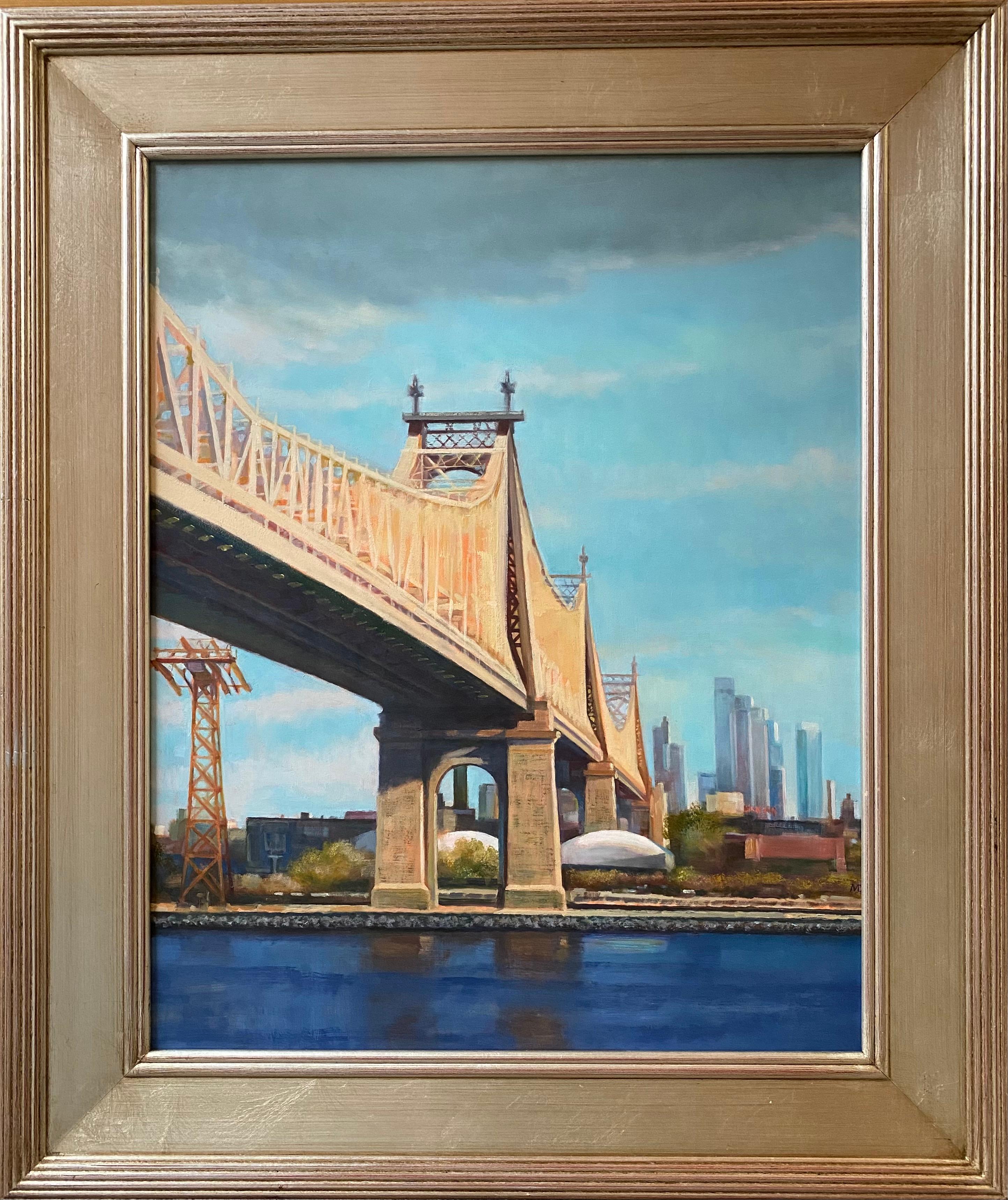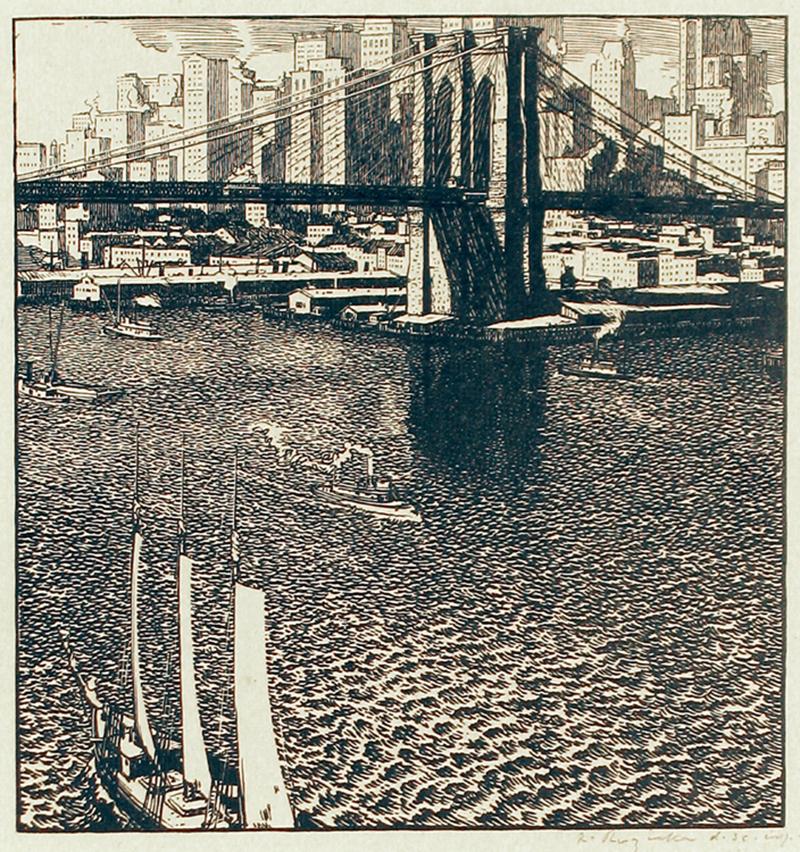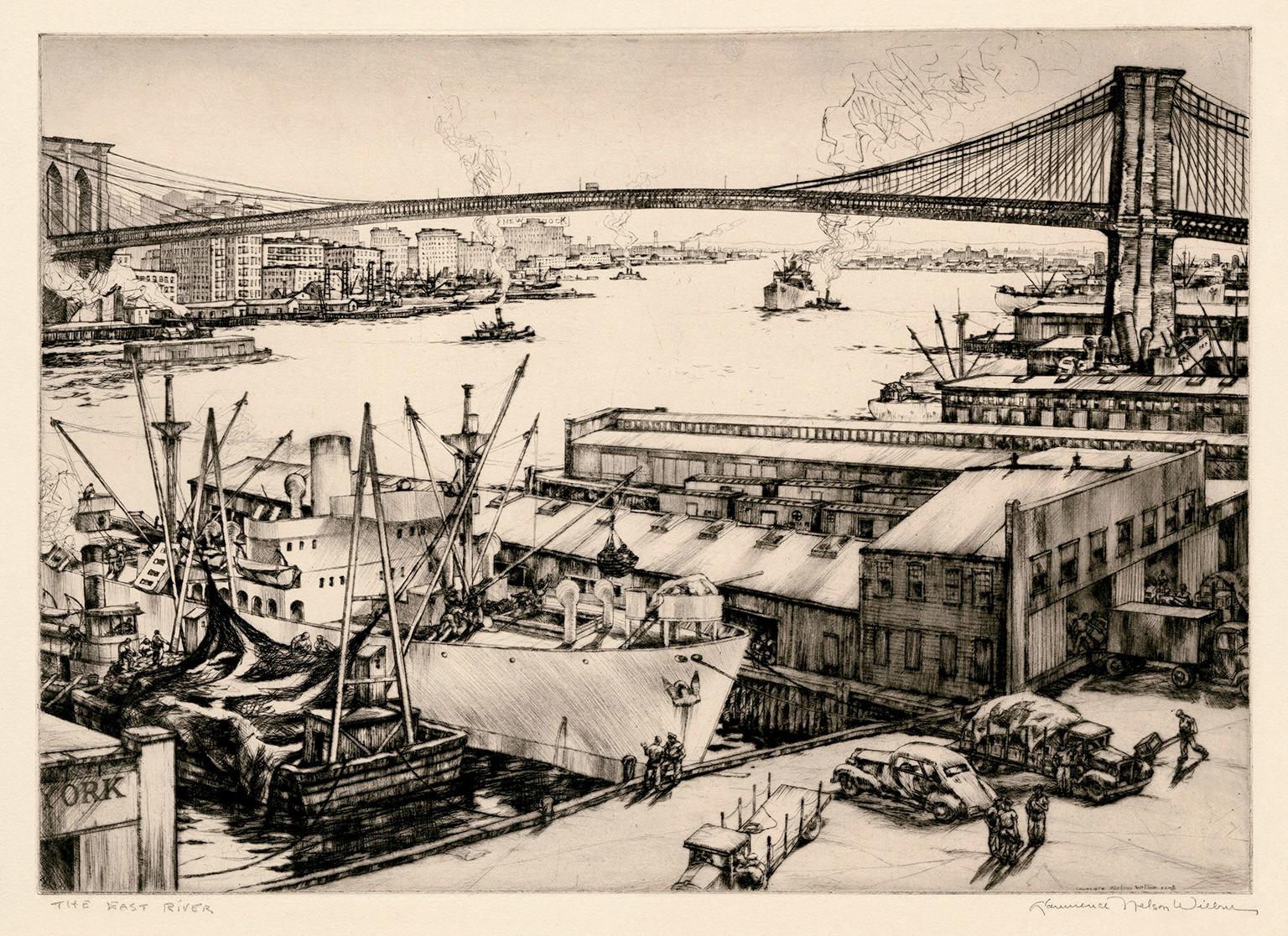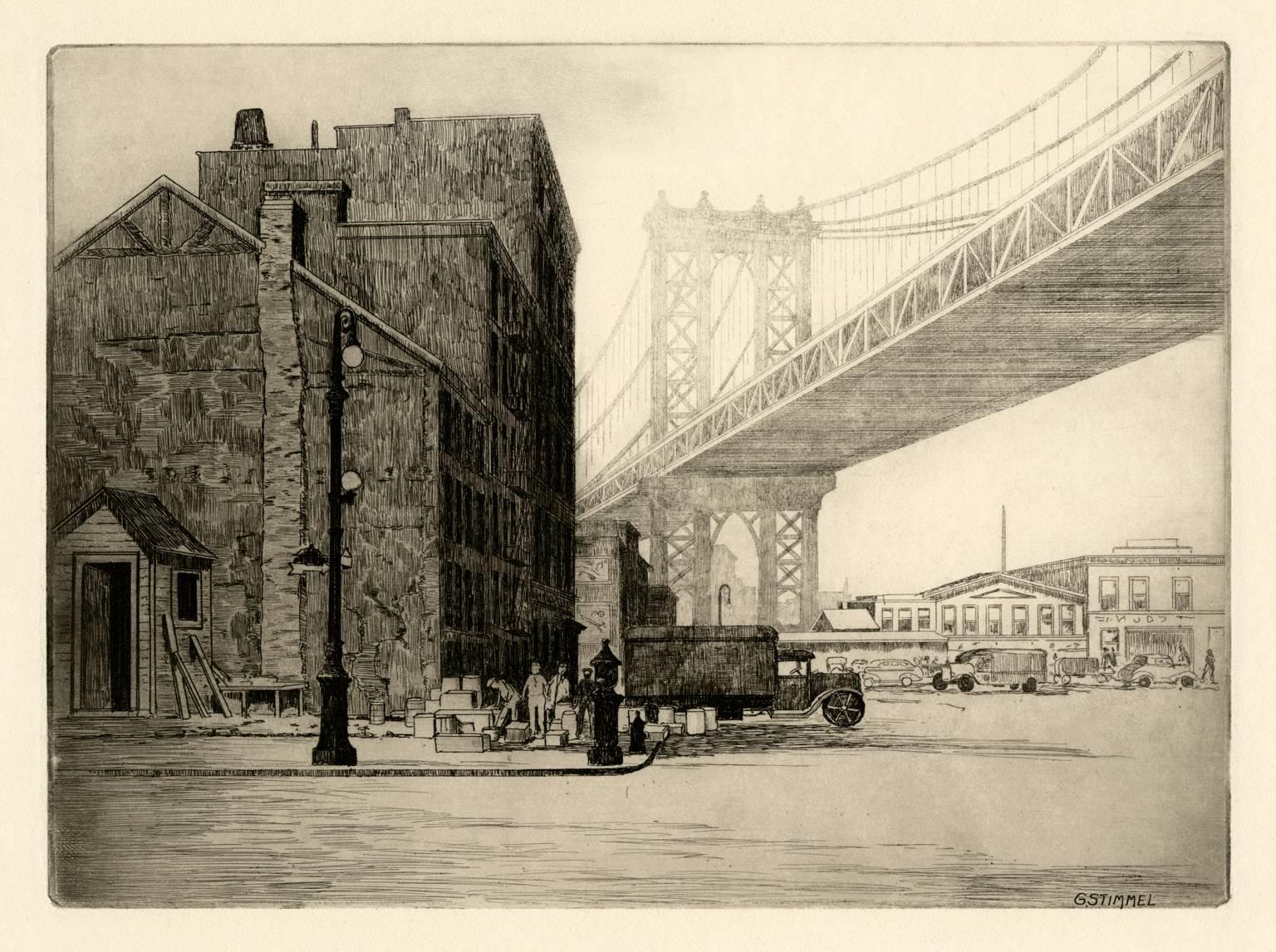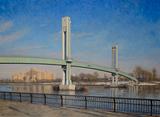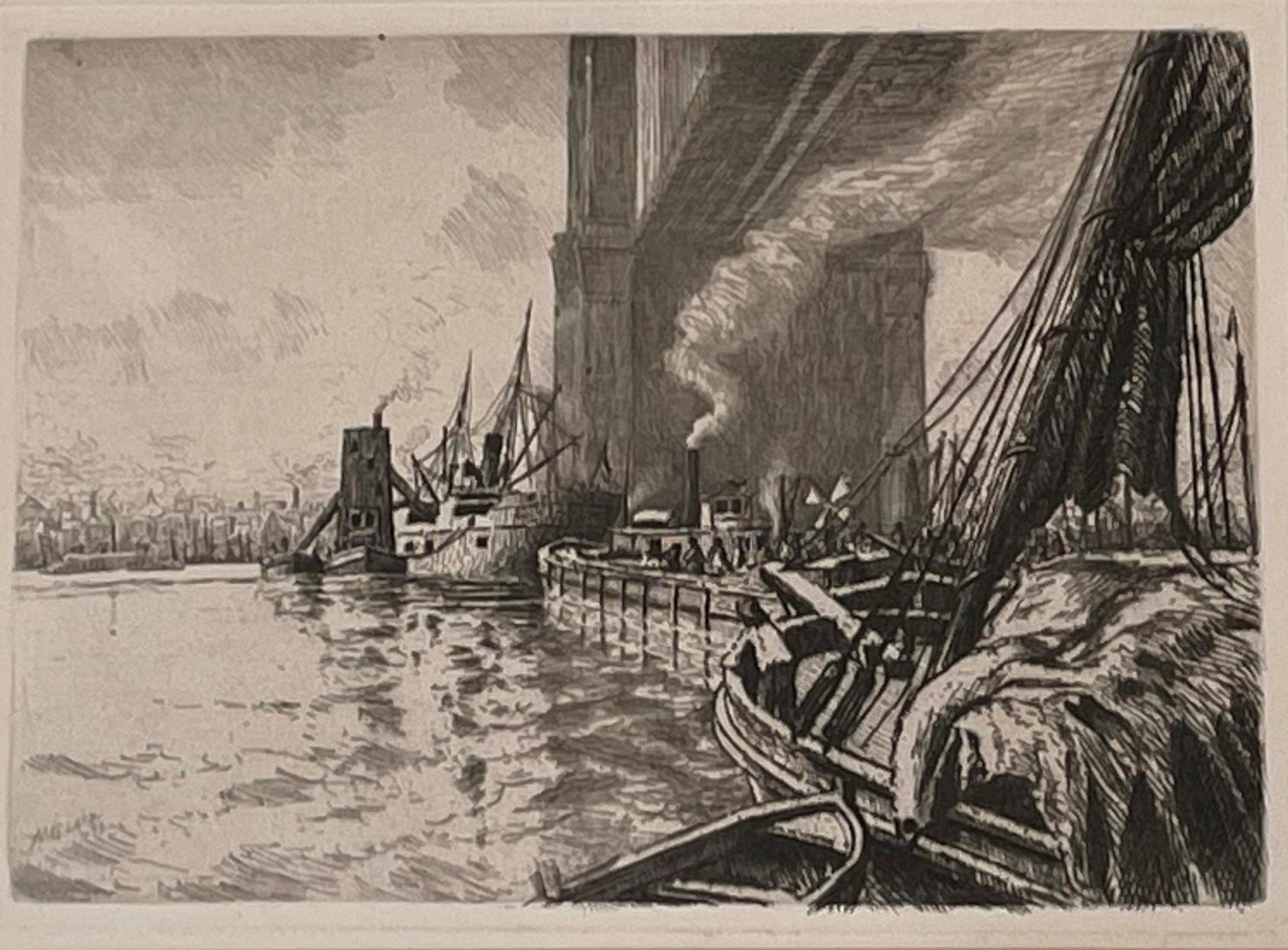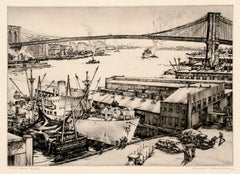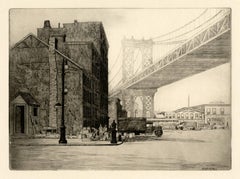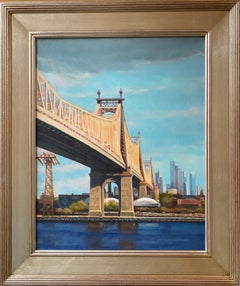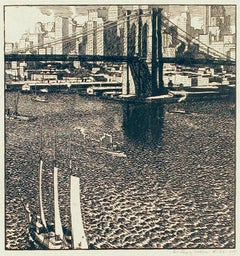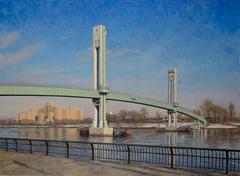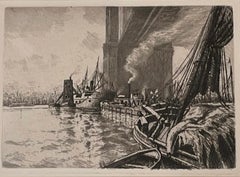Items Similar to 'Delaware River Bridge' — Mid-Atlantic Regionalism
Want more images or videos?
Request additional images or videos from the seller
1 of 3
Anton Schutz'Delaware River Bridge' — Mid-Atlantic Regionalismc. 1927
c. 1927
$350
£265.19
€304.29
CA$492.51
A$541.40
CHF 284.54
MX$6,574.57
NOK 3,549.50
SEK 3,362.91
DKK 2,270.96
About the Item
Anton Schutz, 'Delaware Bridge' (Delaware, New Jersey), etching, c. 1927. Signed in pencil. A superb, richly-inked impression, with skillfully wiped plate tone, on BFK Rives, cream wove paper, the full sheet with margins (1 1/2 to 2 1/8 inches), in excellent condition. Archivally matted to museum standards, unframed.
Image size 11 7/8 x 8 7/8 inches (302 x 225 mm); sheet size 15 7/8 x 12 1/4 inches (403 x 311 mm).
ABOUT THIS IMAGE
The Benjamin Franklin Bridge, originally named the Delaware River Bridge, is a suspension bridge across the Delaware River connecting Philadelphia, Pennsylvania, and Camden, New Jersey. The bridge was dedicated as part of the 1926 Sesquicentennial Exposition, celebrating the 150th anniversary of the signing of the United States Declaration of Independence. At completion, its 1,750-foot (533-meter) span was the world's longest suspension bridge, a distinction it held until the opening of the Ambassador Bridge in 1929. The name was changed to "Benjamin Franklin Bridge" in 1955 when a second Delaware River suspension bridge connecting Philadelphia and New Jersey was under construction (the Walt Whitman Bridge).
ABOUT THE ARTIST
Etcher, painter, and architect, Anton Schutz was born in Germany in 1894. He studied at the University of Munich, earning a double degree in mechanical engineering and architecture. His interests then turned to art, and he attended the Academy of Fine Arts in Munich. After completing his artistic studies, Schutz came to the United States in 1924, where he met Joseph Pennell. He assisted Pennell in his classes at the Art Students League, New York, and became his professional associate.
Schutz was commissioned by The New York Times to make etchings of New York and other American cities. He completed a series of illustrations for the magazine section, traveling as far west as San Francisco. Schutz then traveled to Japan, Russia, and China in 1928 and 1929, creating etchings published by The New York Times and the New York Herald Tribune. The United States Chamber of Commerce commissioned him to create a series of twelve etchings on American cities, later reproduced in Nation’s Business Magazine. Other of his etchings featuring European and American cities were included in publications of the Encyclopaedia Britannica. Schutz also served as the president of the New York Graphic Society and the Louis Icart Society.
The works of Anton Schutz are represented in numerous museum collections, including the Library of Congress, the New York Public Library, the Brooklyn Museum, the Chicago Art Institute, the Cleveland Museum of Arts, the British Museum, the Bibliotheque Nationale de Paris, and the Uffizi Galleries in Florence.
- Creator:Anton Schutz (1894-1977, American)
- Creation Year:c. 1927
- Dimensions:Height: 11.88 in (30.18 cm)Width: 8.88 in (22.56 cm)
- Medium:
- Movement & Style:
- Period:
- Condition:
- Gallery Location:Myrtle Beach, SC
- Reference Number:Seller: 1041751stDibs: LU532311933042
About the Seller
5.0
Recognized Seller
These prestigious sellers are industry leaders and represent the highest echelon for item quality and design.
Platinum Seller
Premium sellers with a 4.7+ rating and 24-hour response times
Established in 1995
1stDibs seller since 2016
321 sales on 1stDibs
Typical response time: 1 hour
Associations
International Fine Print Dealers Association
- ShippingRetrieving quote...Shipping from: Myrtle Beach, SC
- Return Policy
Authenticity Guarantee
In the unlikely event there’s an issue with an item’s authenticity, contact us within 1 year for a full refund. DetailsMoney-Back Guarantee
If your item is not as described, is damaged in transit, or does not arrive, contact us within 7 days for a full refund. Details24-Hour Cancellation
You have a 24-hour grace period in which to reconsider your purchase, with no questions asked.Vetted Professional Sellers
Our world-class sellers must adhere to strict standards for service and quality, maintaining the integrity of our listings.Price-Match Guarantee
If you find that a seller listed the same item for a lower price elsewhere, we’ll match it.Trusted Global Delivery
Our best-in-class carrier network provides specialized shipping options worldwide, including custom delivery.More From This Seller
View All'The East River', Brooklyn Bridge — Mid-Century Realism, New York City
By Lawrence Wilbur
Located in Myrtle Beach, SC
Lawrence Nelson Wilbur (1897-1988), 'The East River', drypoint, edition 65, 1946. Signed, titled, and annotated 'A. Jones Proof 1946' in pencil. Signed and dated in the plate, lower ...
Category
1940s American Modern Landscape Prints
Materials
Drypoint
Manhattan Bridge — 1920s New York City
By George Stimmel
Located in Myrtle Beach, SC
'Manhattan Bridge', etching, c. 1920, proofs only. Signed in ink in the image, lower right. A fine, rich impression, in warm black ink, on cream wove ...
Category
1920s American Realist Landscape Prints
Materials
Etching
'George Washington Bridge (Under Construction)' — 1920s New York City
By Otto Kuhler
Located in Myrtle Beach, SC
Otto Kuhler, 'George Washington Bridge' (under construction) also titled 'The Cables That Hold it All', etching, 1928, edition unknown. An uns...
Category
1920s American Modern Figurative Prints
Materials
Etching
'Brooklyn Bridge' — Iconic New York City Landmark
By Luigi Kasimir
Located in Myrtle Beach, SC
Luigi Kasimir, 'Brooklyn Bridge', color etching with aquatint, 1927, edition 100. Signed in pencil.
A superb impression, with fresh colors, on heavy, cream wove paper; with margins...
Category
1920s American Modern Landscape Prints
Materials
Etching, Aquatint
New York (from Ports of America)
By Louis Orr
Located in Myrtle Beach, SC
Louis Orr, 'New York' (from the portfolio 'Ports of America', published by Yale University Press, 1928), etching, 1925, edition not stated. Signed and titled in pencil. Signed in the...
Category
1920s Realist Landscape Prints
Materials
Etching
'Chicago Harbor' — Urban Realism
By Anton Schutz
Located in Myrtle Beach, SC
Anton Schutz, 'Chicago Harbor', etching, edition 100, c. 1927. Signed and numbered '87/100' in pencil. Annotated '580 Chicago Harbor', in another hand, in the bottom left margin. A f...
Category
1920s American Realist Landscape Prints
Materials
Etching
You May Also Like
59th Street Bridge, original realist New York City landscape
By Michael Davis
Located in Spring Lake, NJ
A veritable life line for New York City that connects the boroughs of Manhattan to Queens, NYC artist Michael Davis painted this original landscape in a realist style to ensure capturing the might and splendor that such an architectural and engineering achievement represents to civilization and certainly to New York. A colorist, Davis seeks simplicity of expression, with clean lines paired with love of his subject matter balanced with aquamarine skies and sapphire blue water. His addition of sky scrapers in the background adds scale and dimension. Davis earned his BFA from Pratt Institute of NYC where he is a life member of the famed Art Students League. Davis' work has shown in the Grand Central Gallery, the National Academy of Design, the Salmagundi Club and the National Arts Club among others. This original oil painting is shown in a champagne silver plein air frame...
Category
21st Century and Contemporary Realist Landscape Paintings
Materials
Oil
The Brooklyn Bridge
By Rudolph Ruzicka
Located in New York, NY
Born in Bohemia in what is now the Czech Republic, Rudolph Ruzicka emigrated to the United States when he was ten years old. His family settled in Chicago, where Ruzicka worked as a ...
Category
20th Century American Realist Landscape Prints
Materials
Engraving
Footbridge, Framed
By Bennett Vadnais
Located in Fairfield, CT
Represented by George Billis Gallery, NYC & LA --Much of Bennett Vadnais’ subject matter comes from his surroundings in Manhattan and Brooklyn. With a strong background in plein ...
Category
21st Century and Contemporary American Realist Landscape Paintings
Materials
Aluminum
UNDER THE BROOKLYN BRIDGE, EAST RIVER.
By Charles Frederick William Mielatz
Located in Portland, ME
Mielatz, Charles W.(American, born Germany, 1864-1919) UNDER THE BROOKLYN BRIDGE, EAST RIVER. Published by the New York Etching Club, circa 1893. Sign...
Category
1890s Landscape Prints
Materials
Etching
Brooklyn Transfer East River Crossing, Oil on Canvas Painting Frederick Reimers
Located in Atlanta, GA
"Bklyn Transfer, East River Crossing" by Frederick Reimers (1911–1994)
This unique, captivating cityscape painting by Frederick Reimers (USA, 1911–1994) offers a dynamic view of the ...
Category
20th Century Modern Landscape Paintings
Materials
Canvas, Oil, Acrylic
Crossings
By Frederick Mershimer
Located in New York, NY
CROSSINGS
Contemporary artist Frederick Mershimer created the mezzotint engraving entitled "Crossings" in 1998. This impression is signed, titled, and dated in pencil. The printed ...
Category
Late 20th Century American Realist Landscape Prints
Materials
Mezzotint
